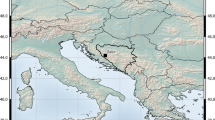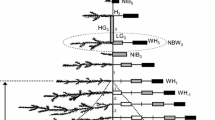Abstract
Key message
Retention of 10–16-year-old balsam fir needles increased significantly with cumulative spruce budworm defoliation. Mean needle longevity on defoliated 50-year-old fir was almost double that for undefoliated 25-year-old fir.
Abstract
Conifers experiencing environmental change affecting photosynthetic capacity have been observed to compensate by adjusting foliage longevity and increasing retention of old foliage. Defoliation by spruce budworm [Choristoneura fumiferana (Clem.)] is one such change, therefore, it was hypothesized that conifers, such as balsam fir [Abies balsamea (L.) Mill.] may increase foliage life spans to compensate for losses of photosynthetic capacity to defoliation. Understanding foliage longevity is a key component of predicting foliage complement, which is the main driver of effects of defoliation on forest growth and productivity. Defoliation and needle loss were assessed on 16 age classes of foliage on mid-crown branches sampled from 134 mature balsam fir trees near Amqui and Causapscal, Quebec, and related to needle age and cumulative defoliation (summed annual defoliation from 2012 to 2016). A general linear mixed model fitted to the needle survivorship data accounted for 68% of the total deviance. The model interaction term of cumulative defoliation with foliage age indicated that for foliage ages less than about 9 years, increased cumulative defoliation resulted in lower needle survival, possibly because of backfeeding of spruce budworm on 5+-year-old foliage, while in the older age classes, needle survival increased with increasing cumulative defoliation. For the oldest, 11–16-year-old foliage age classes, 10–16% more foliage per age class was retained under severe defoliation than under light defoliation. As a result, median needle age increased from 9.5 to 10.4 years as cumulative defoliation increased from 0 to 500%. Mean needle longevity of 9.5 years for 50-year-old balsam fir with low defoliation observed in this study was considerably higher than the mean of 5.5 years previously observed for 22- to 27-year-old fir in Cape Breton, Nova Scotia. Such differences in needle longevity and retention would cause considerable differences in predictions of tree growth using foliage-based stand growth models.




Similar content being viewed by others
References
Balster NJ, Marshall JD (2000) Decreased needle longevity of fertilized Douglas-fir and grand fir in the northern Rockies. Tree Physiol 20:1191–1197
Baskerville G, Kleinschmidt S (1981) A dynamic model of growth in defoliated fir stands. Can J Forest Res 11:206–214
Batzer HO (1973) Defoliation by the spruce budworm stimulates epicormic shoots on balsam fir. Environ Entomol 2:727–728
Chabot BF, Hicks DJ (1982) The ecology of leaf life spans. Annu Rev Ecol Evol Syst 13:229–259
Clark J (1961) Photosynthesis and respiration in white spruce and balsam fir. NY State College of Forestry, Syracuse (Tech. Publ. No. 85.)
Collingwood GH, Brush WD (1984) Balsam fir. Knowing your trees. The American Forestry Association, Washington, DC, pp 102–103
Fleming RA, Piene H (1992a) Spruce budworm defoliation and growth loss in young balsam fir: period models of needle survivorship for spaced trees. For Sci 38:287–304
Fleming RA, Piene H (1992b) Spruce budworm defoliation and growth loss in young balsam fir: cohort models of needle schedules for spaced trees. For Sci 38:678–694
Gan S, Amasino RM (1997) Making sense of senescence: molecular genetic regulation and manipulation of leaf senescence. Plant Physiol 113:313–319
Keeler HL (1908) Our native trees and how to identify them: a popular study of their habits and their peculiarities. Charles Schribner’s Sons, New York
Leopold AC (1978) The biological significance of death in plants. In: Behnke JA (ed) The biology of aging. Plenum Press, New York, pp 101–114
MacLean DA (1980) Vulnerability of fir-spruce stands during uncontrolled spruce budworm outbreaks: a review and discussion. For Chron 56:213–221
MacLean DA (2016) Impacts of insect outbreaks on tree mortality, productivity, and stand development. Can Entomol 148:S138–S159
MacLean DA, Lidstone RG (1982) Defoliation by spruce budworm: estimation by ocular and shoot-count methods and variability among branches, trees, and stands. Can J For Res 12:582–594
MacLean DA, MacKinnon WE (1996) The accuracy of aerial sketch mapping of spruce budworm defoliation in New Brunswick. Can J For Res 26:2099–2108
MacLean DA, MacKinnon WE (1998) Sample sizes required to estimate defoliation of spruce and balsam fir caused by spruce budworm accurately. North J Appl For 15:135–140
MacLean DA, Erdle TA, MacKinnon WE, Porter KB, Beaton KP, Cormier G, Morehouse S, Budd M (2001) The spruce budworm decision support system: forest protection planning to sustain long-term wood supply. Can J For Res 31:1742–1757
Maillette L (1982) Needle demography and growth pattern of Corsican pine. Can J Bot 60:105–116
McCullagh P, Nelder JA (1989) Generalized linear models, 2nd edn. Chapman Hall/CRC Press, Boca Raton
Miller CA (1963) The spruce budworm. Mem Entomol Soc Can 95:12–19
Piene H (1980) Effects of insect defoliation on growth and foliar nutrients of young balsam fir. For Sci 26:665–673
Piene H, Fleming RA (1996) Spruce budworm defoliation and growth loss in young balsam fir: spacing effects on needlefall in protected trees. For Sci 42:282–288
Piene H, MacLean D, Wall RE (1981) Effects of spruce budworm caused defoliation on the growth of balsam fir: experimental design and methodology. In: Information Report M-X-128. Canadian Forestry Service, Maritimes Forest Research Centre, Fredericton, NB, Canada
QMRNF: Québec Min. Res. Natur. et de la Faune (2011) Aires infestées par la tordeuse des bourgeons de l’épinette au Québec en 2011. http://www.mffp.gouv.qc.ca/publications/forets/fimaq/insectes/tordeuse/TBE_2011_P.pdf. Accessed 18 Oct 2016
QMRNF: Québec Min. Res. Natur. et de la Faune (2012) Aires infestées par la tordeuse des bourgeons de l’épinette au Québec en 2012. http://www.mffp.gouv.qc.ca/publications/forets/fimaq/insectes/tordeuse/TBE_2012_P.pdf. Accessed 18 Oct 2016
QMRNF: Québec Min. Res. Natur. et de la Faune (2016) Aires infestées par la tordeuse des bourgeons de l’épinette au Québec en 2016. http://www.mffp.gouv.qc.ca/publications/forets/fimaq/insectes/tordeuse/TBE_2016_P.pdf. Accessed 18 Oct 2016
R Development Core Team (2016) R: a language and environment for statistical computing. http://www.R-project.org. Accessed 8 June 2017
Reich PB, Koike T, Gower ST, Schoettle AW (1995) Causes and consequences of variation in conifer leaf life-span. In: Smith WK, Hinckley TM (eds) Ecophysiology of coniferous forests. Academic Press, San Diego, pp 225–250
Reich PB, Oleksyn J, Modrzynski J, Tjoelker MG (1996) Evidence that longer needle retention of spruce and pine populations at high elevations and high latitudes is largely a phenotypic response. Tree Physiol 16:643–647
Rowe JS (1972) Forest regions of Canada. Canadian Forestry Service, Ottawa (Publ. No. 1300)
Schoettle AW (1990) The interaction between leaf longevity and shoot growth and foliar biomass per shoot in Pinus contorta at two elevations. Tree Physiol 7:209–214
Weaver LM, Gan S, Quirino B, Amasino RM (1998) A comparison of the expression patterns of several senescence-associated genes in response to stress and hormone treatment. Plant Mol Biol 37:455–469
Whitney GG (1982) A demographic analysis of the leaves of open and shade grown Pinus strobus L. and Tsuga canadensis (L.) Carr. New Phytol 90:447–453
Woo HR, Kim HJ, Nam HG, Lim PO (2013) Plant leaf senescence and death: regulation by multiple layers of control and implication for aging in general. J Cell Sci 126:4823–4833
Acknowledgements
Funding for this study was provided by the Atlantic Canada Opportunities Agency Atlantic Innovation Fund project (Grant no 203544) entitled ‘Early Intervention to Suppress a Spruce Budworm Outbreak’. We thank Shawn Donovan for assisting with branch sampling and providing data on the sample plots, and Jessica Cormier, Rebecca Landry, and Holly Campbell for assisting with branch measurements.
Author information
Authors and Affiliations
Corresponding author
Ethics declarations
Conflict of interest
The authors declare that they have no conflict of interest.
Additional information
Communicated by T. Koike.
Rights and permissions
About this article
Cite this article
Doran, O., MacLean, D.A. & Kershaw, J.A. Needle longevity of balsam fir is increased by defoliation by spruce budworm. Trees 31, 1933–1944 (2017). https://doi.org/10.1007/s00468-017-1597-4
Received:
Accepted:
Published:
Issue Date:
DOI: https://doi.org/10.1007/s00468-017-1597-4




